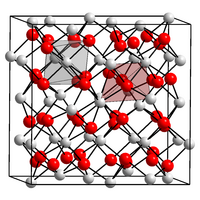Scandium oxide
 |
|
| Names | |
|---|---|
|
IUPAC name
Scandium(III) oxide
|
|
| Other names
Scandia, scandium sesquioxide
|
|
| Identifiers | |
|
3D model (JSmol)
|
|
| ECHA InfoCard | 100.031.844 |
|
PubChem CID
|
|
|
|
|
|
| Properties | |
| Sc2O3 | |
| Molar mass | 137.910 g/mol |
| Appearance | White powder |
| Density | 3.86 g/cm3 |
| Melting point | 2,485 °C (4,505 °F; 2,758 K) |
| insoluble in water | |
| Solubility | soluble in hot acids (reacts) |
| Hazards | |
| NFPA 704 | |
|
Except where otherwise noted, data are given for materials in their standard state (at 25 °C [77 °F], 100 kPa).
|
|
|
|
|
| Infobox references | |
Scandium(III) oxide, Sc2O3, or scandia, is a high melting rare earth oxide. It is used in the preparation of other scandium compounds as well as in high-temperature systems (for its resistance to heat and thermal shock), electronic ceramics, and glass composition (as a helper material).
Scandium(III) oxide adopts a cubic crystal structure (point group: tetrahedral (Th), space group: Ia3) containing 6-coordinate metal centres.Powder diffraction analysis shows Sc−O bond distances of 2.159–2.071 Å.
Scandium Oxide is an insulator with a band gap of 6.0 eV.
Scandium oxide is the primary form of refined scandium produced by the mining industry. Scandium-rich ores, such as thortveitite (Sc,Y)2(Si2O7) and kolbeckite ScPO4·2H2O are rare, however trace amounts of scandium are present in many other minerals. Scandium oxide is therefore predominately produced as a by-product from the extraction of other elements.
Scandium oxide is the primary form of refined scandium produced by the mining industry, making it the start point for all scandium chemistry.
Scandium oxide reacts with most acids upon heating, to produce the expected hydrated product. For example, heating in excess aqueous HCl produces hydrated ScCl3·nH2O. This can be rendered anhydrous by evaporation to dryness in the presence of NH4Cl, with the mixture then being purified by removal of NH4Cl by sublimation at 300-500 °C. The presence of NH4Cl is required, as the hydrated ScCl3·nH2O would otherwise form a mixed oxychloride upon drying.
...
Wikipedia

